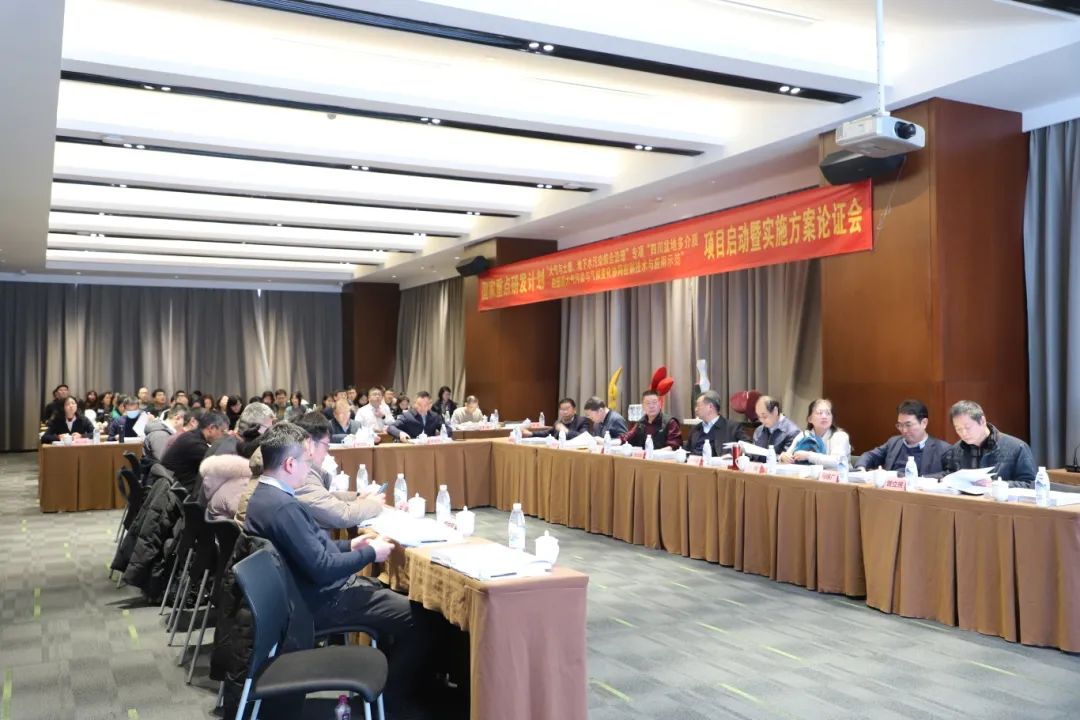The Session on the Kick-off and Implementation Plan Reasoning for the National Key Research and Development Program Led by Tianfu Yongxing Laboratory Was Convened
Release Date:2024-02-05
On February 2, the Session on the Kick-off and Implementation Plan Reasoning for the Special Project Titled “Collaborative Control Technology and Application Demonstration of Multi-media and Cross-strata Air Pollution and Climate Change in Sichuan Basin” was successfully convened in Chengdu. This project is part of the national key research and development program “Comprehensive Control of Air, Soil, and Ground Water Pollution” led by Tianfu Yongxing Laboratory (hereinafter referred to as “the Laboratory”). The session was attended by notable experts, including HAO Jiming, an academician of the Chinese Academy of Engineering and a professor of Tsinghua University, ZHANG Yuanhang, an academician of the Chinese Academy of Engineering, Director of Tianfu Yongxing Laboratory, and a professor of Peking University, and LIU Wenqing, an academician of the Chinese Academy of Engineering and a researcher of Chinese Academy of Sciences’ Anhui Institute of Optics and Fine Mechanics. During the session, speeches were delivered by WANG Lei, Director of the Administrative Center for China’s Agenda 21 Department of Ecological Environment, ZHAO Lechen, Chief Engineer and a member of the Department of Ecology and Environment of Sichuan Province’s Leading Party Group, and KUANG Liangyi, Deputy Director of Chengdu Municipal Bureau of Ecological Environment and a member of the Bureau’s Leading Party Group, respectively.

HAO Jiming, an academician of the Chinese Academy of Engineering, served as the leader of the Implementation Plan Reasoning Expert Team. The expert team also includes academicians LIU Wenqing and ZHANG Yuanhang of the Chinese Academy of Engineering, CHAI Fahe, a researcher of the Chinese Research Academy of Environmental Sciences, GONG Shanling, a researcher of the Chinese Academy of Meteorological Sciences, HU Min, a professor of Peking University’s College of Environmental Sciences and Engineering, YE Hong, a researcher of the Environmental Scientific Society of Sichuan Province, FENG Yinchang, a professor of Nankai University’s College of Environmental Science and Engineering, and ZHENG Junyu, a professor of Hong Kong University of Science and Technology (Guangzhou).
At the kick-off session, Director WANG Lei gave a speech and explained project management related policies and requirements. Director WANG Lei emphasized the need for the project team to conduct in-depth research on subsequent work in accordance with national needs, so as to provide scientific support for addressing actual problems.
On behalf of the Department of Ecology and Environment of Sichuan Province, Chief Engineer ZHAO Lechen expressed his heartfelt gratitude to the academicians and experts for their long-term concern, help, and strong support for air pollution prevention and control in Sichuan, as well as in addressing climate change.
In his speech, Deputy Director KUANG Liangyi highlighted the significant role this project plays in advancing the local area’s scientific research level and fostering the enhancement of the efficiency of pollution and carbon reduction synergy in the region. He encouraged participants to seize the opportunity and devote themselves to research, thereby making contributions to efforts such as creating a demonstration zone for carbon peaking.
Later on, XIE Shaodong, the project leader
and a professor of Peking University’s College of Environmental Sciences and Engineering, presented a report detailing the project’s basic information, content, assessment indicators and methods, schedule, and management. Following this, subject leaders delivered individual reports on subjects’ preliminary research, tasks, assessment indicators, and schedule. After reviewing reports on the project and subjects, the expert group unanimously agreed to approve the project implementation plan, and provided valuable opinions on project research content, application prospects, feasibility of the research plan, research program, and schedule.
On behalf of the project team, Professor XIE Shaodong pledged that the team will strictly implement the management regulations of the national key research and development program, and make sure the responsibilities of the project undertaking institutions are met to guarantee effective project implementation. Besides, the team will effectively strengthen the alignment and coordination between subjects to achieve the project’s research goals and complete tasks on schedule. Professor XIE Shaodong added that project achievements will yield considerable social and economic benefit in terms of theoretical method innovation, technology integration, and demonstrative application. In addition, they will support Chengdu’s and Chongqing’s high-quality development, and the in-depth improvement of PM2.5 pollution in autumn and winter as well as the control of O3 pollution in summer through providing approaches and strategic plans for achieving the reduction of PM2.5 and O3 and establishing a demonstration zone for carbon peaking. Consequently, the achievements are going to serve as important references for other Chinese regions and showcase a promising potential for widespread promotion and application.
In Academician ZHANG Yuanhang’s concluding remarks, he pointed out that this session has laid a solid groundwork for the project’s smooth implementation. He urged the project team to heed attending experts’ opinions and suggestions, thus proceeding with project implementation and achievement realization, and boosting high-quality development and in-depth improvement of environment and air quality in Sichuan Basin.
Following project kick-off, the Laboratory will collaborate with Peking University, the Sichuan Academy of Environmental Policy and Planning, Chengdu Academy of Environmental Sciences, Chongqing Ecological Environment Monitoring Center, Sichuan University, and other colleges and institutes to jointly pursue breakthroughs in five subjects. These institutions are going to analyze the structural characteristics of boundary layers under different topographies of Sichuan Basin, the laws of meteorological evolution, and the key driving factors affecting changes in air pollution. Through elucidating the formation mechanism of secondary pollution coupling under multi-media interaction, the institutions will establish a business-oriented platform for three-dimensional monitoring, early warning, and decision-making support for cross-media secondary pollutants. Ultimately, they plan to propose fundamental air quality improvement strategies and a green and low-carbon development path incorporating the regulation principles for secondary pollutants and climate synergy in Sichuan Basin.
 Tel
Tel Postal
Postal Address
Address